Articles
Making a pre-1850 Martin pyramid bridge replacement
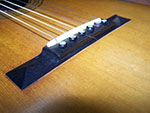 The guitar in for repair is a Martin size 1 from approximately 1846, virtually identical to the “Col. Wilkins” Martin 1-26 that is profiled in the new book “Inventing the American Guitar: The pre-Civil War innovations of CF Martin and his Contemporaries.” This guitar needed many repairs but is in good shape overall, and making an accurate reproduction of the original style of bridge was of primary importance. Since the guitar matches the specs of the “Wilkins” 1-26 I used that type of Martin pyramid bridge as the style for this guitar. Luckily, I own a Martin of the same era that has this type of bridge, so I had one on hand that I could use as a model in the shop as I made the new bridge.
The guitar in for repair is a Martin size 1 from approximately 1846, virtually identical to the “Col. Wilkins” Martin 1-26 that is profiled in the new book “Inventing the American Guitar: The pre-Civil War innovations of CF Martin and his Contemporaries.” This guitar needed many repairs but is in good shape overall, and making an accurate reproduction of the original style of bridge was of primary importance. Since the guitar matches the specs of the “Wilkins” 1-26 I used that type of Martin pyramid bridge as the style for this guitar. Luckily, I own a Martin of the same era that has this type of bridge, so I had one on hand that I could use as a model in the shop as I made the new bridge.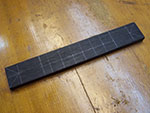
I’ve made many pyramid bridges for 19th century guitars, and this order of operationsworks well. It is difficult to get some of the shaping and transitions right if 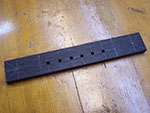 the proper order isn’t observed. First, the ebony blank wasthicknessed on thePerformax sander to near finished height. Next step is to mark out the pin hole locations, edges of the plateau that forms the center of the bridge, and the apex of thepyramids. After the “map” is marked out, the pin holes are drilled with a 3/16” bit).
the proper order isn’t observed. First, the ebony blank wasthicknessed on thePerformax sander to near finished height. Next step is to mark out the pin hole locations, edges of the plateau that forms the center of the bridge, and the apex of thepyramids. After the “map” is marked out, the pin holes are drilled with a 3/16” bit). 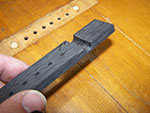
Now it’s time to establish the ramp from the pyramid to the plateau of the bridge. Note that the pyramid hasn’t been shaped yet. I use a ¼” round rasp to cut this facet. 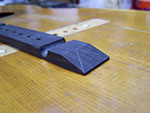 The cut is made with a rounded shape from the front to back edge of the bridge, it is not flat. That is, the bridge is thicker in the center of this cut than at either edge.This is partially visible in the photo below, but more visible in later pics). Next, the bevel that forms the outer face of the pyramid is cut, using a flat rasp (I’ve also done this on a belt sander), then that facet is marked with in pencil to mark the location of the outer corners of the pyramid.
The cut is made with a rounded shape from the front to back edge of the bridge, it is not flat. That is, the bridge is thicker in the center of this cut than at either edge.This is partially visible in the photo below, but more visible in later pics). Next, the bevel that forms the outer face of the pyramid is cut, using a flat rasp (I’ve also done this on a belt sander), then that facet is marked with in pencil to mark the location of the outer corners of the pyramid.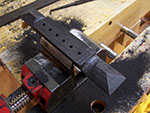
Using a flat rasp, the next facet to be shaped is the sides of the pyramid, made by 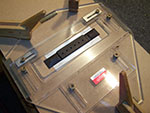
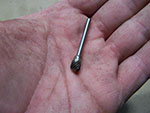 cutting a flat face to the line marked on the end of the pyramid. I’ve left the peak intact toward the plateau, to be shaped later. The next step uses
cutting a flat face to the line marked on the end of the pyramid. I’ve left the peak intact toward the plateau, to be shaped later. The next step uses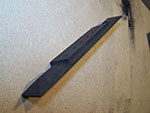 a saddle routingfixture, Fordam router and rounded bit to cut the ‘lip’ in the back edge of the bridge that was common in Martins from the 1840s. The bridge has been secured to a flat boardwith double stick tape and once the fixture that guides the cutter is properly aligned the cut is made.
a saddle routingfixture, Fordam router and rounded bit to cut the ‘lip’ in the back edge of the bridge that was common in Martins from the 1840s. The bridge has been secured to a flat boardwith double stick tape and once the fixture that guides the cutter is properly aligned the cut is made.
It is time now to shape the inner portion of the pyramid that lies between the peak of the pyramid and the plateau of the center of the bridge.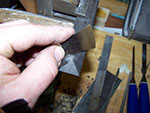
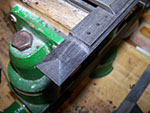 The proper shape of this area is not faceted but rather quite rounded front to back and slightly scooped from the peak to the plateau. It is a compound shape that if not done correctly will stand out in comparison to an original. I shape this area first with small files then follow with a curved scraper blade that helps refine the curves and smooth the surface.
The proper shape of this area is not faceted but rather quite rounded front to back and slightly scooped from the peak to the plateau. It is a compound shape that if not done correctly will stand out in comparison to an original. I shape this area first with small files then follow with a curved scraper blade that helps refine the curves and smooth the surface.
The final part of the shaping is done to the plateau of the bridge, radiusing it slightly 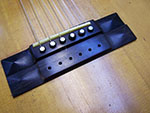 from front to back and end to end. I did not take any photos of that in progress but I generally do it with files and thesame small scrapers used for the inner aspect of the pyramid. Once the final shaping is done the bridge is sanded lightly with grits starting at 220 and progressing through 1200. The 1200 leaves the ebony with the soft luster that mimics the look of an old bridge. Then the bridge is touched lightly with fret board oil, which adds a little to that luster. This photo shows the new bridge along side the original that was used as the model.
from front to back and end to end. I did not take any photos of that in progress but I generally do it with files and thesame small scrapers used for the inner aspect of the pyramid. Once the final shaping is done the bridge is sanded lightly with grits starting at 220 and progressing through 1200. The 1200 leaves the ebony with the soft luster that mimics the look of an old bridge. Then the bridge is touched lightly with fret board oil, which adds a little to that luster. This photo shows the new bridge along side the original that was used as the model.
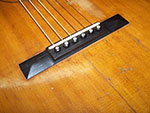 Once installed on the guitar the saddle slot is located and routed using a Foredom power tool with the precision router base and saddle slotting jig. A new saddle is fashioned of ivory, pins fitted and the guitar strung up. The final photo is of the new bridge on the old guitar.
Once installed on the guitar the saddle slot is located and routed using a Foredom power tool with the precision router base and saddle slotting jig. A new saddle is fashioned of ivory, pins fitted and the guitar strung up. The final photo is of the new bridge on the old guitar.